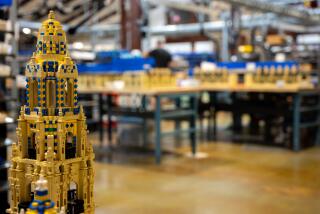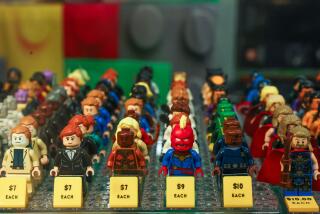Playing for Keeps : From Etch-a-Sketch to Barbie, Baby Boomers Pass On Their Favorites
Chris Goodman, a Playa del Rey father of two, has more than treasured memories of his favorite childhood toys. He managed to save a few of the things he held dear for his own family.
So, when his children pull out his Lincoln Logs, he helps them build the same cabins he made when he was young.
And every night, when 5-year-old Kimberly goes to bed, she is accompanied by her father’s Winnie the Pooh bear. Never mind that the eyes, nose and mouth are missing. “She’s really fallen for my old bear,” says Goodman. “His eyes were worn off, and I told (Kimberly) that I wore the eyes off with all the love.
“I’ve managed to keep them from Ninja Turtles so far. It’s the simple things. The older toys’ quality stood out--without all the bells and whistles on them. I think, frankly, we all like things we’re familiar with. And there is a certain nostalgia, passing them down. We harken back to
the good old days.”
Trendy toys come and go, but not the classics. Indeed, there are certain toys whose appeal endures throughout the decades: Etch-a-Sketch, Lincoln Logs, Barbie, Tinkertoys and Mr. Potato Head. Baby boomers played with them as children; now their children are twisting knobs, building forts and assembling cosmic cruisers.
“In this recession, consumers are trying to get the most value for their money, so they’re shopping carefully and sticking with products that they know, the basics,” says Bob Seligman of New York-based Toy and Hobby World magazine. “And then there are the boomers. They’re passing on toys they enjoyed as children to their children.”
So what makes a toy a classic?
They “have an innate play value for the child because a child can express (his or her) fantasies indefinitely through them,” says Maggie Agoglia, vice president of Child Growth and Development, a New York research company. “Barbie is a beautiful doll that encompasses (certain) cultural standards of beauty, and she lets little girls live out their fantasies.
“You can’t do anything wrong with wooden blocks,” Agoglia adds. “You can create fantastic tracks and buildings. Other things like Etch-a-Sketch have a unique twist for children and an element of magic. There is something magical in turning the knob on Etch-a-Sketch because you can’t see what is happening under that screen that makes it draw.”
“About 6,000 toys are introduced yearly,” says Diane Cardinale, assistant communications director of the Toy Manufacturers of America Inc., a New York-based trade association. “Manufacturers don’t know what makes a toy a classic. They wish they did.”
It’s easy to understand why: Toys are big business.
The 240 members of Toy Manufacturers of America account for 90% of toy sales in this country, a figure that will reach just over $13 billion this year, Cardinale says. Sixty percent of that--or $7.8 billion--will be forked over this holiday season alone, with parents spending an average of $120 to $150 per child.
At Toys R Us, which has 497 stores nationwide and whose international sales last year reached $5.5 billion, spokeswoman Angela Bourdon says: “Pick-up-Sticks, Legos and Etch-a-Sketch are the staples of the business that sell well every year.”
Some manufacturers who’ve had enduring blockbuster toys say the key to classics is making them evolve to reflect changing times.
“Take something like Barbie,” says Lisa German, manager of marketing communications for Mattel in El Segundo. “We’ve kept her current with what’s going on in the world and society. With her wardrobe, she can be a doctor, go on a first date, get married.”
Even Mr. Potato Head has changed from his original 1952 design. His plastic features initially were assembled on a real spud, but now kids put the potato face on a plastic replica. And there is a Super Silly Mr. Potato Head, who comes with an assortment of goofy headgear, including a cowboy hat with an arrow shot through it.
Other researchers note that many classic toys share one telling trait--they are not mechanized.
“The child supplies most of the imaginative work for the toys,” says Marilyn Motz, assistant professor of popular culture at Bowling Green University. “They play with them longer, and I’d say that’s why they last. They are of an abstract nature. Like Legos, they’re not limited to a time period or culture, so that the child can adapt them to whatever is their interest that week. One week they’re a fortress, the next a space shuttle and the next a castle.”
And aside from “violent toys, the alienating game of Nintendo, and Barbie, who gives little girls an unrealistic idea of women,” the classics tend to be better for children than their trendy counterparts, says Los Angeles psychiatrist Carole Lieberman.
“Many of these toys touch a universal chord in children,” she says. “Children haven’t changed psychologically, so they still go through the same stages they have throughout time and will appreciate the same toys.
“With toys like Pinocchio (and Disney characters), there is the whole script that goes with it and we remember the story about lying and the nose growing. And in many of the old toys, you’ll notice that they often require participation from an older sibling or a parent, which promotes family interaction.”
At Toys R Us in Culver City, Jan Goodman, wife of Chris, the father who saved his Lincoln Logs, stands before a newfangled talking duck. “My kids are really into Legos,” she says. “The 2-year-old is really into them and (the 5-year-old) is into them too. It’s the building and imagination that keeps them involved for a long time, versus the duck who quacks and then the thrill is all over.”
Of course, while that may hook the kids, one shouldn’t underestimate the special attraction of nostalgia--at least on their parents.
“Nostalgia is an important part of what makes something popular,” says toy expert Agoglia. “I think most men, when it comes to buying a train set for their sons, remember the Lionel Train set. It’s the same thing with Etch-a-Sketch--people remember what a neat thing it was for them when they were little. It also helps parents regain the joy of playing.”
Although Milton Bradley has come out with a video version of Candyland, the popular board game for small children, some parents refuse to let their old favorite enter the electronic age.
“We’re getting the regular Candyland game, which is what I had when I was little,” says Jan Goodman.
And with that, she and daughter Kimberly turn their backs on the duck that can quack even in bathwater.
More to Read
The biggest entertainment stories
Get our big stories about Hollywood, film, television, music, arts, culture and more right in your inbox as soon as they publish.
You may occasionally receive promotional content from the Los Angeles Times.










